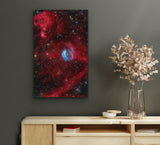Fal1 - A New Discovery in Monoceros
-
This is a rare limited edition Giclée print, available in these quantities:
50 - small 12 x 21.4 inches
20 - medium 18 x 28 inches
10 - large 26 x 41 inches
All of these prints have a 1-inch white border and ship worldwide.
-
I am very proud to share with you all my very first discovery of a nebula! Fal1 is a large primarily [Oiii] nebula in Monoceros, just off of the wings of the Seagull Nebula. The nature of the nebula is not fully understood and will need some spectra for more details, but here are some ideas. Fal1 could likely be an ionized ISM region formed by a hot subdwarf star, similar to Ou4 the squid nebula. But then again the small central bubble means it could be a true planetary nebula, however this is less likely due to the lack of a good candidate star. The star that Xavier Strottner identified in this image as the hot subdwarf is: http://simbad.u-strasbg.fr/simbad/sim-id?Ident=Gaia%20EDR3%203100775558029162880&NbIdent=1
Given the distance to this star, and the angular size of the object, we can estimate its size to span 58 light-years (+/- 9% error).
Here is an analysis of the Sii, Ha, and Oiii continuum images:

All of these images are stretched to the same relative brightness but this nebula is way brighter in Oiii than any of the other respective wavelengths. Hints of related Ha and Sii structures only showed on the bright left region of the object. That big line is the geostationary satellite highway. The keen amongst you may also notice StDr44 near the bottom middle riding the large wave of Ha/Sii. I don't think StDr44 has been captured in the Sii wavelength so its neat to see it has a lot!
Compared with the size of the moon:

This nebula was discovered after a couple weeks of literally pointing my telescope at random spots in the sky doing deep Oiii images, and continuum subtractions. My first hint of this nebula looked like this:

This is a heavily downscaled (for noise reduction) Oiii continuum photo. Definitely, something is there, but much more exposure was needed. The capture process took quite a while since I had to wait for the bomb cyclone in California to pass. My telescope is located at Sierra Remote Observatory, which made the capture of this image much more expeditious than it otherwise would've been.
This image was captured using my FSQ106 setup at SRO, you can find more info about it here.
This image and discovery deserve special thanks to Marcel Drechsler and Xavier Strottner, who have been an enormous help and great resource for learning about the discovery process. It wouldn't have happened without their guidance and inspiration!





